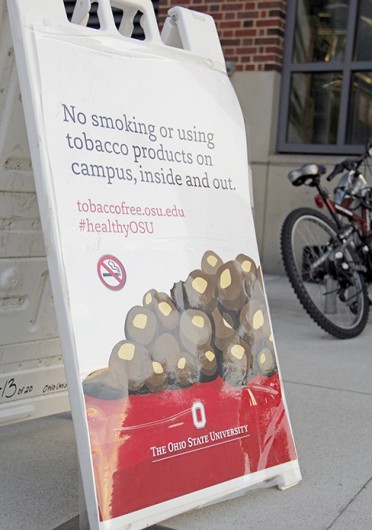
A ‘no smoking’ sign outside the Ohio Union Jan. 12. OSU’s tobacco ban went into effect Jan. 1, and $100,000 has been budgeted for signage and banners promoting the policy.
Credit: Ritika Shah / Asst. photo editor
Ohio State has spent roughly half its $100,000 signage budget to make sure when visitors come to campus, they remember to put out their cigarettes.
OSU’s tobacco ban went into effect Jan. 1, and $43,000 has already been spent for signs and banners promoting the policy, university spokesman Gary Lewis said in an email.
The money used comes from “benefit funds,” not a single department, and is administered on behalf of OSU by the Office of Human Resources. Facilities Operations and Development is responsible for placing and maintaining the signs around campus.
Lewis did not give further explanation on what constitutes university benefit funds.
Signs have been placed outside several university buildings, including the Ohio Union, and banners have been hung in parking garages.
One student said the $43,000 was money ill-spent.
“I don’t think that’s the best use of that money. I think that makes sense to get the word out, but at the same time I don’t think it’s very effective,” said Trevor Kononenko, a first-year in pre-business.
Kononenko said he walks by the Wexner Medical Center every day, which has been tobacco-free since 2006, and sees employees and others smoking near a large sign that advises visitors of the ban.
Karl Fredal, a fourth-year in economics and German, said the problem lies with the policy itself, and the university shouldn’t be trying to regulate student health.
“Naturally I’m sort of biased but I think it’s kind of a silly policy,” said Fredal, a regular smoker. “I hardly see how that will be beneficial to the student body as a whole.”
With a campus job and a busy class schedule, Fredal said it isn’t realistic for him to leave campus to smoke. During his time on campus, he said he hasn’t been strictly following the ban, but has been retreating to more concealed locations when he needs to smoke.
“I disagree with the ban, but I’m not going to walk across the Oval and smoke if it’s against university policy,” he said.
Fredal said the money spent on signs was “pretty much a waste of money” and doesn’t see the method as being effective in deterring students, staff, faculty or visitors from smoking.
The campus-wide ban was announced in 2013, and was set to take effect Aug. 1. In August, however, university officials said the ban would not be enforced until 2014.
Tobacco ban violations are not handled by the University Police, but instead by the Office of Human Resources.
Interim President Joseph Alutto said in August the ban would be beneficial to the overall goal of making the university a healthier place.
“This is very important for everyone and we’re going to do everything we can … to encourage that behavior and over time give people time to adjust,” Alutto said in an interview with The Lantern.
Sanctions under the Student Code of Conduct stipulate that students receive hearings after a reported tobacco-ban violation, with punishments ranging from letters of reprimand, which are written letters issued because of a student’s misconduct, to dismissal.
Lewis said in September the university’s priority was communicating the policy and making sure departments and supervisors put pressure on their constituents.
Undergraduate Student Government President Taylor Stepp said he’s pleased with the way the ban is being enforced.
“The way that we (USG) look at it is, we really don’t want to see law enforcement or current public safety entities to be used to enforce this ban,” said Stepp, a fourth-year in public affairs. “We believe (police enforcement is) a poor use of our resources, but … no one wants to walk by and get smoke in their face.”
Stepp said the ban is a “pretty large priority for central administration,” who consider the policy to be an investment for the campus.
To mark the 50th anniversary of the Surgeon General’s Report on Smoking that linked tobacco use to lung cancer and chronic lung and heart disease, OSU held an event Friday at the Ohio Union to celebrate “50 years of progress and millions of lives saved.” The event was expected to cost approximately $5,000, said Bri Loesch, a spokeswoman for the College of Public Health.
The Ohio Board of Regents, which holds no ruling authority over Ohio’s education institutions, passed a resolution suggesting Ohio’s public universities move toward tobacco-free campuses in July 2012. Later that year, the OSU Board of Trustees agreed to explore the suggestion.
According to the American Nonsmokers’ Rights Foundation, tobacco-free policies have been enacted at 811 college campuses in the nation. Besides cigarettes, the tobacco bans include tobacco chew, snuff and snus, which is a “spitless,” moist powder tobacco pouch, according to the American Cancer Society.
Kononenko, who doesn’t use tobacco but has friends who do, said he doesn’t understand why chewing tobacco, or “dip,” is included in the ban.
“The only damage being done (with dip) is being done to themselves,” he said. “There’s no secondhand smoke equivalent for dip … I don’t think people should be penalized.”
In OSU’s policy, e-cigarettes are also banned from campus because “there is insufficient evidence that these devices positively affect smoking and they are not approved by the Food and Drug Administration as smoking cessation devices.”
Stepp said there has been “a lot of miscommunication on what the expectations of the ban are,” but thinks students, staff and visitors will adjust to the policy in time.
“Really the message I’m understanding from the university, is this is more of a culture change, kind of like the no cycling zone around the Oval,” he said.


